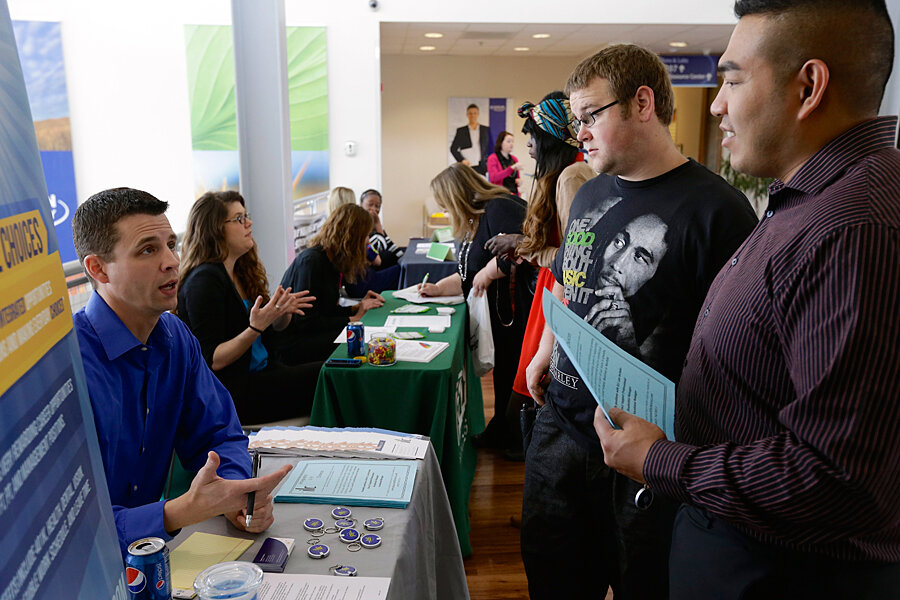US gains impressive 288,000 jobs – but the economy isn't in the clear yet
Loading...
| Washington
US employers hired 288,000 new workers in April, topping forecasters’ expectations and bolstering the view that the economy is reviving from a slow winter affected by severe weather.
Anerica’s official unemployment rate fell to 6.3 percent, down from 6.7 percent the month before.
The two figures, released by the Labor Department early each month, are the most commonly cited gauges of how the job market is doing.
On the surface at least, both numbers show big improvement.
The 288,000 tally of workers hired is the best monthly jobs count in more than two years and the fourth best during the post-recession presidency of Barack Obama. The gains finally bring total employer payrolls close to pre-recession levels. (They’re already higher, in fact, if government payrolls are excluded from the total.)
And the unemployment rate improved by an unusually large degree, dipping close to where it stood (at 6.1 percent) just before the financial crisis in 2008 deepened with the collapse of Lehman Brothers.
But these two indicators aren’t beaming any “all clear” signal regarding the long-troubled job market. Yes, they show progress, but the United States still has a way to go on the march toward recovery, and it’s helpful to consider the headline numbers in full context.
Here’s a job market report card using a range of useful indicators:
Not back to normal in total jobs. Although the number of jobs on employer payrolls is nearly as high as it was when the recession began at the end of 2007 (it was 138.4 million then, 138.3 million now), America’s working-age population is larger now. So there’s still a big jobs gap.
Still, the 288,000 jump in April bested forecasts that were generally in the 200,000 range. The stock market didn’t appear to budge much on the “up side” surprise, just as it didn’t panic earlier this week when first-quarter economic growth came in on the down side of expectations – partly because of the winter weather.
Nevertheless, the Dow Jones Industrial Average has risen to a new record this week, consistent with the notion of an improving job market. Some other indicators are also positive. An Employment Trends Index tracked by the Conference Board in New York is up 5 percent compared with a year ago. And economists are projecting steady if unspectacular job gains. “We foresee ... monthly payroll gains averaging around 195,000” this year, writes Gregory Daco of Oxford Economics.
‘Real’ jobless rate still high. In an economy operating at its normal trend, unemployment would be about 5.2 to 5.6 percent of the workforce, according to estimates by Federal Reserve. The 6.3 percent jobless rate is still a good way from that level.
The Fed is aware that, despite improvement in the jobless rate, lots of weakness remains in the job market. In a stronger economy, several million potential workers now on the sidelines might rejoin the labor force.
In April, by contrast, the decline in unemployment stemmed from adults leaving the workforce rather than finding new jobs. The jobless rate, in fact, comes from a Labor Department survey that's separate from the job creation numbers – a survey of households rather than of employers. Sometimes the two surveys send conflicting messages in a given month, because of the natural volatility of the household survey.
The April exodus from the labor force may also reflect the phaseout of extended unemployment benefits. Many long-term unemployed people could collect benefits if they stayed in the labor force and kept looking for work. But with the extended benefits expired, more people may be dropping out of the job hunt.
Wages improving ... slowly. Hourly earnings didn’t budge in April from the previous month. When inflation is taken into account, that implies some slippage.
Average hourly earnings for US workers, at $24.31 in April, haven’t advanced much since 2007 on an inflation-adjusted basis. They’re up more than 30 cents per hour, thanks to modest gains coming in the past two years. But in a stronger job market, pay raises would be bigger.
Quality of jobs is a question. Employers have been hiring in most industries, from professional services to construction and manufacturing. But some watchers of the job market have voiced concern about the quality of the new jobs.
According to analysis by the National Employment Law Project, low-wage industries accounted for 22 percent of job losses during the recession, but 44 percent of job gains over the past four years. Middle-wage industries were responsible for 37 percent of job losses but only 26 percent of recent job gains, and high-wage industries accounted for 41 percent of job losses but 30 percent of recent job gains.
Overall mood is improving. An April Gallup survey found 30 percent of US adults saying now is a “good time to find a quality job,” up from 8 percent in 2011. The latest reading is the most optimistic one since early 2008 as the recession was beginning.
Another barometer of worker confidence is the “quit rate,” the number of workers who choose to leave their job. In very weak job markets, relatively few workers feel this is a wise move. The quit rate plunged during the recession, and it remains below pre-recession levels. But it’s been edging generally upward since 2009, the Labor Department reports.








